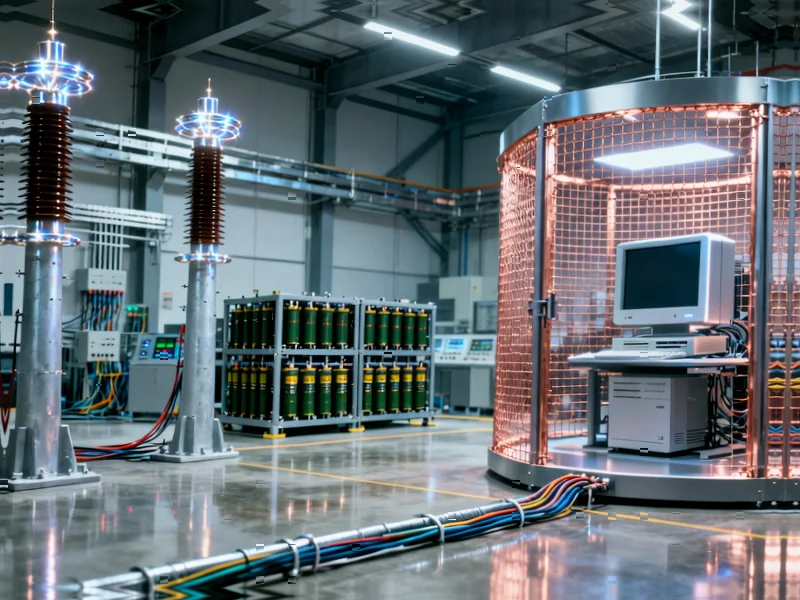According to The Economist, Europe faces a staggering €800 billion grid modernization challenge to meet its 2050 electrification goals, with national operators planning massive investments including Italy’s Terna (€18 billion through 2028), France’s RTE (€100 billion 2025-2040), and TenneT (€200 billion by 2034). The Delft Electrical Sustainable Power Lab is using sophisticated “digital twin” technology to model grid complexities, revealing critical vulnerabilities as renewable integration accelerates. Germany now experiences negative electricity prices 10% of the time in 2024, up from 3% in 2023, indicating severe grid congestion and storage limitations. The connection backlog is equally alarming, with Italy receiving 350GW of renewable applications despite planning for only 65GW by 2030, while Germany faces battery project applications exceeding current capacity by 20 times.
Table of Contents
The Digital Twin Revolution in Grid Management
The emergence of supercomputer-powered digital twins represents a fundamental shift in how grid operators approach system reliability. Unlike traditional differential equations that provided limited predictive capabilities, digital twins create living simulations that can model everything from lightning strikes to cyberattacks in real-time. This technology becomes increasingly critical as grids transition from predictable fossil fuel generation to intermittent renewable energy sources that create complex, non-linear power flows. The ability to simulate cascading failures before they occur could prevent continent-wide blackouts similar to the 2022 Ukraine incident or the 2023 Spain-Portugal frequency collapse.
The Hidden Economic Costs of Grid Congestion
While the €800 billion price tag seems staggering, the real economic impact lies in the opportunity costs of delayed connections and inefficient power markets. Negative electricity prices aren’t just market anomalies—they represent billions in lost revenue and misallocated capital. When Germany pays consumers to take excess power 10% of the time, it signals fundamental structural failures in transmission capacity and battery storage deployment. This congestion directly undermines Europe’s industrial competitiveness, particularly for energy-intensive manufacturing that’s already struggling with electricity costs two to three times higher than in the United States.
Regulatory Bottlenecks Outpace Technical Challenges
The most surprising revelation isn’t the technical complexity but the regulatory paralysis slowing critical infrastructure. The Italy-Slovenia interconnector project, authorized on the Italian side since 2012 but still awaiting Slovenian approval, exemplifies how cross-border politics trump economic efficiency. First-come, first-served connection policies in Germany have created a speculative application market where entrepreneurs file for capacity they may never use, further clogging the system. These regulatory failures suggest that even with perfect technology and unlimited funding, Europe’s grid modernization could stall without fundamental governance reforms.
The Storage Deployment Dilemma
Europe’s battery storage boom—adding 8.8GWh in 2024, ten times 2020 levels—creates its own set of challenges. While essential for grid stability, poorly located battery farms can exacerbate congestion by drawing power from already strained transmission lines. The optimal strategy requires co-locating storage with renewable generation sites, but market incentives often push developers toward cheaper land regardless of grid impact. This misalignment between private investment decisions and public infrastructure needs represents a critical policy gap that could undermine the effectiveness of Europe’s storage investments.
Broader Competitiveness Implications
The grid crisis extends far beyond energy markets to threaten Europe’s entire economic model. As Mario Draghi’s competitiveness report highlighted, energy costs represent the foundational challenge for European industry. Without reliable, affordable electricity, the continent risks losing advanced manufacturing, data centers, and emerging technologies like green hydrogen production to regions with more robust infrastructure. The coming decade will determine whether Europe can build the grid backbone needed to support its ambitious climate goals while maintaining industrial relevance in a rapidly evolving global economy.
Related Articles You May Find Interesting
- Google’s TPU Crisis: 8-Year-Old Chips at 100% Utilization
- Virgin Media O2 and Starlink Forge UK Satellite Mobile Alliance
- PDC’s Osiris Module Brings Supercomputer Power to Space Missions
- GenAI’s Productivity Promise: 7.5 Hours Weekly Time Savings
- Microsoft’s $140B AI Bet: Short-Term Pain for Long-Term Dominance?



